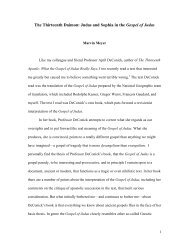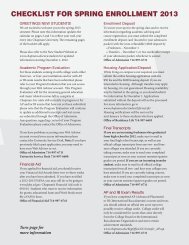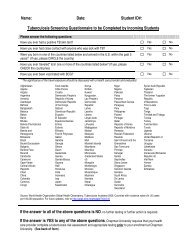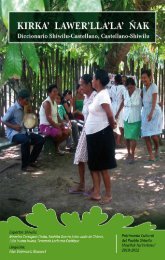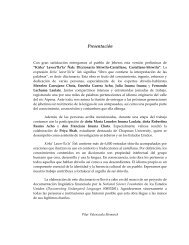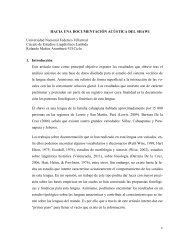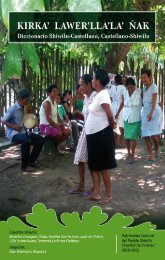“Surplus Humanity” and the Margins of Legality - Chapman University
“Surplus Humanity” and the Margins of Legality - Chapman University
“Surplus Humanity” and the Margins of Legality - Chapman University
Create successful ePaper yourself
Turn your PDF publications into a flip-book with our unique Google optimized e-Paper software.
Do Not Delete 12/12/2010 7:34 PM<br />
44 <strong>Chapman</strong> Law Review [Vol. 14:1<br />
India.‖ 290 PIL emerged precisely at <strong>the</strong> moment <strong>of</strong> <strong>the</strong> collapse <strong>of</strong><br />
<strong>the</strong> nationalist development project.<br />
Progressive PIL decisions by <strong>the</strong> courts brought major<br />
changes in, among o<strong>the</strong>r things, <strong>the</strong> state <strong>of</strong> urban life. These<br />
actions included removal <strong>and</strong> relocation <strong>of</strong> large urban industries<br />
to outside city limits, 291 <strong>the</strong> conversion <strong>of</strong> all public transport <strong>and</strong><br />
private commercial transport to <strong>the</strong> use <strong>of</strong> compressed natural<br />
gas, 292 ridding <strong>the</strong> River Ganges <strong>of</strong> effluents, 293 <strong>and</strong> removal <strong>of</strong><br />
garbage from <strong>the</strong> cities. 294 The courts‘ involvement extended into<br />
oversight <strong>of</strong> implementation <strong>of</strong> <strong>the</strong>ir directives. 295 Encouraged by<br />
judicial pronouncements, in 1990, <strong>the</strong> Indian Law Commission<br />
recommended a new law to give statutory basis to a right <strong>of</strong><br />
slum-dwellers to resettlement, preceding destruction <strong>of</strong> <strong>the</strong>ir<br />
homes. 296 No such law was ever enacted. Similarly, an attempt<br />
to amend <strong>the</strong> Constitution to make <strong>the</strong> right to housing a<br />
fundamental right failed. Neoliberalism had arrived to change<br />
not only <strong>the</strong> rules <strong>of</strong> <strong>the</strong> game, but <strong>the</strong> game itself.<br />
B. Encroachers in <strong>the</strong> Showcase City<br />
PIL may well have stayed on its path, had not <strong>the</strong> global<br />
rules <strong>of</strong> <strong>the</strong> game changed so markedly with <strong>the</strong> neoliberal turn.<br />
In its new iteration, PIL was used by <strong>the</strong> courts to assume <strong>the</strong><br />
role <strong>of</strong> policy maker <strong>and</strong> policy enforcer with <strong>the</strong> backing <strong>of</strong> <strong>the</strong><br />
urban pr<strong>of</strong>essional-managerial classes, who, under <strong>the</strong> spell <strong>of</strong><br />
ideologies <strong>of</strong> corporate capital, have turned away from <strong>the</strong> state<br />
as <strong>the</strong> primary orchestrator <strong>of</strong> change. The judiciary, <strong>the</strong> nonpolitical<br />
branch <strong>of</strong> government, became an instrumentality to depoliticize<br />
political questions <strong>of</strong> distribution, equity, access, <strong>and</strong><br />
opportunity.<br />
As neoliberal deregulation <strong>of</strong> <strong>the</strong> economy, down-sizing <strong>of</strong> <strong>the</strong><br />
public sector, <strong>and</strong> ―free market‖ ideologies became entrenched,<br />
<strong>the</strong> courts took a dramatic turn. Judicial activism in <strong>the</strong> interest<br />
290 Upendra Baxi, The Avatars <strong>of</strong> Indian Judicial Activism: Explorations in <strong>the</strong><br />
Geography <strong>of</strong> [In]justice, in FIFTY YEARS OF THE SUPREME COURT OF INDIA: ITS GRASP AND<br />
REACH 156, 157 (S. K. Verma, Kusum & A.S. An<strong>and</strong> eds., 2000) (emphasis added).<br />
291 M. C. Mehta v. Union <strong>of</strong> India, Petition No. 13381 (Taj Trapenzium Case 1984).<br />
292 M. C. Mehta v. Union <strong>of</strong> India, Petition No. 13029 (Dehli Vehicular Pollution Case<br />
1985).<br />
293 M. C. Mehta v. Union <strong>of</strong> India, Writ Petition No. 3727 (Ganges Pollution Case<br />
1985).<br />
294 Almitra Patel v. Union <strong>of</strong> India, Writ Petition No. 888 (Garbage Removal Case<br />
1996).<br />
295 See Rajamani, supra note 288, at 315. In this regard, <strong>the</strong> courts were not only <strong>the</strong><br />
arbiters <strong>of</strong> law <strong>and</strong> justice, but also functioned as parallel administrative <strong>and</strong> executive<br />
bodies in matters <strong>of</strong> urban affairs.<br />
296 LAW COMMISSION OF INDIA, ONE HUNDRED THIRTY-EIGHTH REPORT ON<br />
LEGISLATIVE PROTECTION FOR SLUM AND PAVEMENT DWELLERS 26 (1990).




